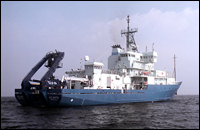PSL Contributes to CalNex Study
May 11, 2010
 Oakhurst, CA field Site. Courtesy Clark King, NOAA |
 R/V Atlantis, Courtesy WHOI |
The NOAA Earth System Research Laboratories (ESRL) Physical Sciences Laboratory will take part in the Research at the Nexus of Climate and Air Quality (CalNex) experiment from May-July 2010 in California and the eastern Pacific. PSL's contributions include installation of integrated wind profiler observing systems at three key ground locations to monitor air transport/ circulation and take surface meteorology measurements. Data collected will be made available in real time. PSL's online Wind Profiler Trajectory Tool will consolidate data from these three sites and 16 additional cooperative agency wind profiler sites allowing researchers to track pollution by displaying forward and backward airmass trajectories at specific locations and different altitudes. In addition, PSL researchers installed and will operate a wind profiler, cloud radar, and flux system aboard the R/V Atlantis and will also launch weather balloons. These measurements will add a critical offshore component to the PSL land-based systems. They are also important to the suite of aerosol and chemical measurements being made on the ship by ESRL's Chemical Sciences Laboratory, the NOAA Pacific Marine Environmental Laboratory (PMEL), and other collaborating partners.
CalNex is a joint field study with the California Air Resources Board (CARB) and the California Energy Commission (CEC) to investigate atmospheric emissions and processes over California and the eastern Pacific coastal region. This multi-agency effort is being led by ESRL and PMEL and includes participants from the University of Colorado Cooperative Institute for Research in Environmental Sciences, NASA, DOE, several universities and other institutions, and industry.
PSL's expertise in collection and analysis of ground and shipboard weather and climate data will contribute to this important study on air quality and climate change. Information collected from this experiment can be utilized by California decision makers in addressing environmental issues.
| Contact: Allen White |